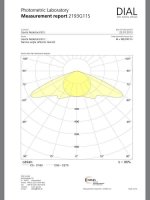Beta Test Team
Member
The following irradiance figures show uniformity over a 3'x3' area with the lamp 3' from the center.
Reflected photons off of walls, ceiling, and floor are not part of these measurements. Also not part of the measurements is overlapping radiation from other luminaires, as is commonly found in growth rooms, chambers, and greenhouses.
The second figure are all 1000W luminaires, well, at least that's true for Gavita and ePapillion.
It seems safe to say the ePapillion, with its less focused footprint, is better suited for 'lighting the room,' not the canopy. And Gavita Pro DE is better suited for 'lighting the canopy,' not the room, with its greater focused footprint. In other words, ePapillion irradiance is lower but its uniformity is greater, and Gavita Pro DE irradiance is greater but its uniformity is lower.
I included the last figure to show typical LED and Greenbeams (Cycloptics 315W) uniformity, as well.
These data were calculated using this method: https://www.cycloptics.com/sites/default/files/USU_functional_efficiency.pdf
Reflected photons off of walls, ceiling, and floor are not part of these measurements. Also not part of the measurements is overlapping radiation from other luminaires, as is commonly found in growth rooms, chambers, and greenhouses.
The second figure are all 1000W luminaires, well, at least that's true for Gavita and ePapillion.
It seems safe to say the ePapillion, with its less focused footprint, is better suited for 'lighting the room,' not the canopy. And Gavita Pro DE is better suited for 'lighting the canopy,' not the room, with its greater focused footprint. In other words, ePapillion irradiance is lower but its uniformity is greater, and Gavita Pro DE irradiance is greater but its uniformity is lower.
I included the last figure to show typical LED and Greenbeams (Cycloptics 315W) uniformity, as well.
These data were calculated using this method: https://www.cycloptics.com/sites/default/files/USU_functional_efficiency.pdf
Last edited:

 for sharing more data
for sharing more data  I can definitely see some potential uses for the information presented, but I do have a couple questions.
I can definitely see some potential uses for the information presented, but I do have a couple questions.

